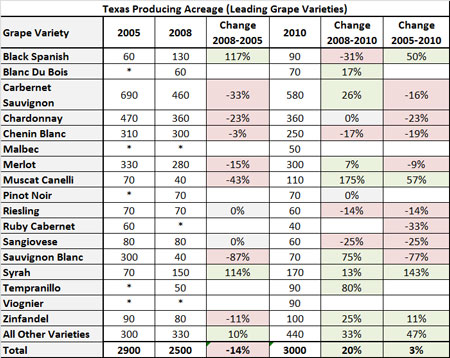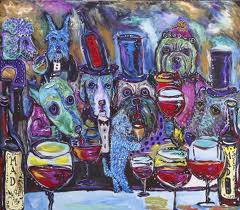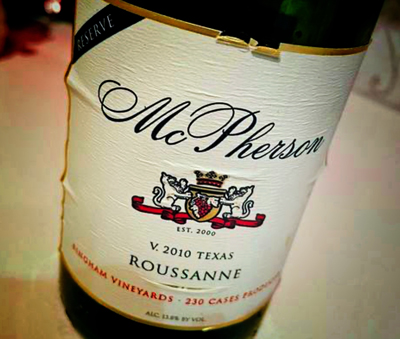Texas Wines Heading South? What Texans Can Learn From The Texas Grape Production and Variety Survey
To some wine consumers, I am sure that this data will fit their category of “Too Much Information” or “Why Should I Care”. The information that I am talking about is in the above table and comes from a survey by the United States Department of Agriculture and The Texas Wine Marketing Research Institute (See: www.nass.usda.gov/tx).
If you haven’t click off this page yet…
I’ve found that it has some nuggets of information that say much about where Texas is going as a wine producing state and perhaps where it isn’t going.
In the above table, I have taken the data on Texas producing grapevine acreage from 2005, 2008 and 2010. It shows the top varieties of grapes (in acres) that have been used to produce juice which, in turn, is used to make Texas wine.
Texas Ain’t Like Bordeaux or Burgundy?
Is Texas like Bordeaux or Burgundy regions of Franc? Well, no!
The climate here is just not close. But, on the top level, the data show that, as of the 2010 harvest, Texas is still by and large emulating Bordeaux and Burgundy by having in its top three slots (by production): Cabernet Sauvignon and Merlot (both Bordeaux varieties) and Chardonnay (the principal white Burgundian grape).
Why? The primary reason that Cabernet, Merlot and Chardonnay are in the top slots is because these are the grapes that California winemakers taught us to drink in the 60s, 70s and 80s. I’s not because they do better than other grapes in the hot Texas sun or manage our notorious late springs freezes. It’s just because when we purchase a bottle of wine in a restaurant, or from a wine shop or supermarket, it is a conditioned response.Think Pavlov’s dogs here.
A secondary proof of the aforementioned premise is evident in the data, too. Notice the acreage dedicated to Pinot Noir. Stop, and think a second: this is Texas Pinot Noir! Why would anybody in their right mind try to grow this cool weather, finicky grape in the land-o-the-blast-furnace weather. My theory is that there are Texas growers, or more likely winemakers, who have customers that were brainwashed into buying Pinot Noir to the point were they would actually seriously consider putting a bottle of Texas Pinot in their shopping cart. Go figure!
But, there is more good news than bad news in these numbers. While there is a whopping 41 percent of the Texas grape crop locked up in these four cool weather French grape varieties, the percentage is down from over 50 percent in 2005. At least, the trend over the period 2005 thru 2010 is heading south.
Texas Wines Heading South?
Yep, that’s what I said…heading south. While there is a trend toward a lower percentage of the Texas grape production in Cab, Merlot, Chardonnay and Pinot, there is good news: a concomitant increase in the production of grapes that originated in more southern climes (the warmer regions of Europe).
For example, grape varieties in Texas that have shown a substantial increase in production are Muscat Canelli (from Italy), Syrah (from the Rhone Valley in southern France). The five year increase in production of these two grape varieties is respectable. Frankly, the amount of acreage dedicated to Syrah surprised me. To me, it is also a little scarry.
In percentage increase between 2005 and 2010, Texas-grown Muscat Canelli and Syrah grapes are followed by Tempranilo (Spain), Zinfanel (related to Primativo from Italy) with the jury needing more and better data on Viognier (Rhone Valley) and Malbec (made famous by Argentina’s warm Mendoza region).
Even More to Hope For the Future
Additional rays of hope are provided in the change in the “All Other Varieties” category which has taken a big bump. In this grouping, you will find Tourgia Nacional (from Portugal), Dolcetto and Aglianico (both from Italy), Tannat (from who-knows-where but made famous in Uruguay) and Vermentino (Italy and Sardinia) and Roussanne (southern France). In a review of my top 10 wines of 2011, I called out 2011 as “The Year of Texas Roussanne”. There was a smattering of it made, but everyone of them that I tasted was a spot-on good wine, which prompted me to ask a follow-up question: “With Texas Roussanne, why do we need Chardonnay”.
More hope comes from the two non-vinifera grapes being grown in Texas. These are a red grape called Black Spanish (also known as Lenoir) and a white grape called Blanc Du Bois. Both showed gains in the 2005 thru 2010 period, but perhaps Blanc Du Bois is closer to the mark as being ready to lead the charge as a mainstream wine and compete head-to-head with wines made from white vinifera grapes.
If you see something else in the number that I’ve missed or feel like I’m off base, please let me and the readership of VintageTexas know by posting your comment in the space provided.
Also, if you are unfamiliar with any of the grape varieties (those that aren’t Cab, Merlot, Chardonnay or Pinot) do a search on VintageTexas (text box in upper right side of page) or search on Google. Education is just a click away!
— — — — —
In a subsequent blog, I will look into the stats from the non-productive acres of Texas grapes. These will most likely show what grape varieties are already planted but will be coming into production in the coming years.




This chart is one of the best pieces of news to come out in years, Russ. Planting to terroir will only make Texas wine better.
Now, if we can get the bozos in the Legislature to pay attention. ….
GREAT post!!! This is very good news; we need much more Viognier, Tempranillo and Syrah in Texas. This shows that the wineries and wine drinkers are catching on. I am selling a lot of these Texas wines at the resort and guest LOVE them.
We also sell some of those Burgundy and Bordeaux varitales made from Texas grown grapes and they are very drinkable, they just are not as good as their counterparts from their home region or California. In contrast the Viognier, Tempranillo and Syrah made from Texas grown grapes are as good if not BETTER than their counterparts!
Please keep the “too much information” posts coming and we egerly wait for your book to be released in Febuary.
From Les Constable, http://www.brushycreekvineyards.com
Good info. The Texas difference is seen in a lot of ways. My wife Ann really likes her Pinot and we get good pinot from California. Please know that I am always grateful for anyone who helps me find good pinot for Ann. Keep in mind that she really liked the La Rommanee Conti and it was a life changing thing that happened.
So what do we do in Texas. Well Sangiovese made well is about the same density as Pinot and served in a pinot glass is some more fruity than Pinot but really great in its own right. My Sangiovese is not anything like Chianti but more like a fruit forward Pinot. It sells really well.
I think we need to think out of the box and make wines that simply taste great. We cannot force a wine style that doesn’t fit our climate regardless of the grape involved.
Sorry. I know I am preaching to the choir for most but recently some wine snobs have been questioning why Texas wines do not taste like California or French wines. Somehow the answer that this is not California or France doesn’t seem to get through. I am glad sales to these people is not really important. I make wine for my customers.
Les